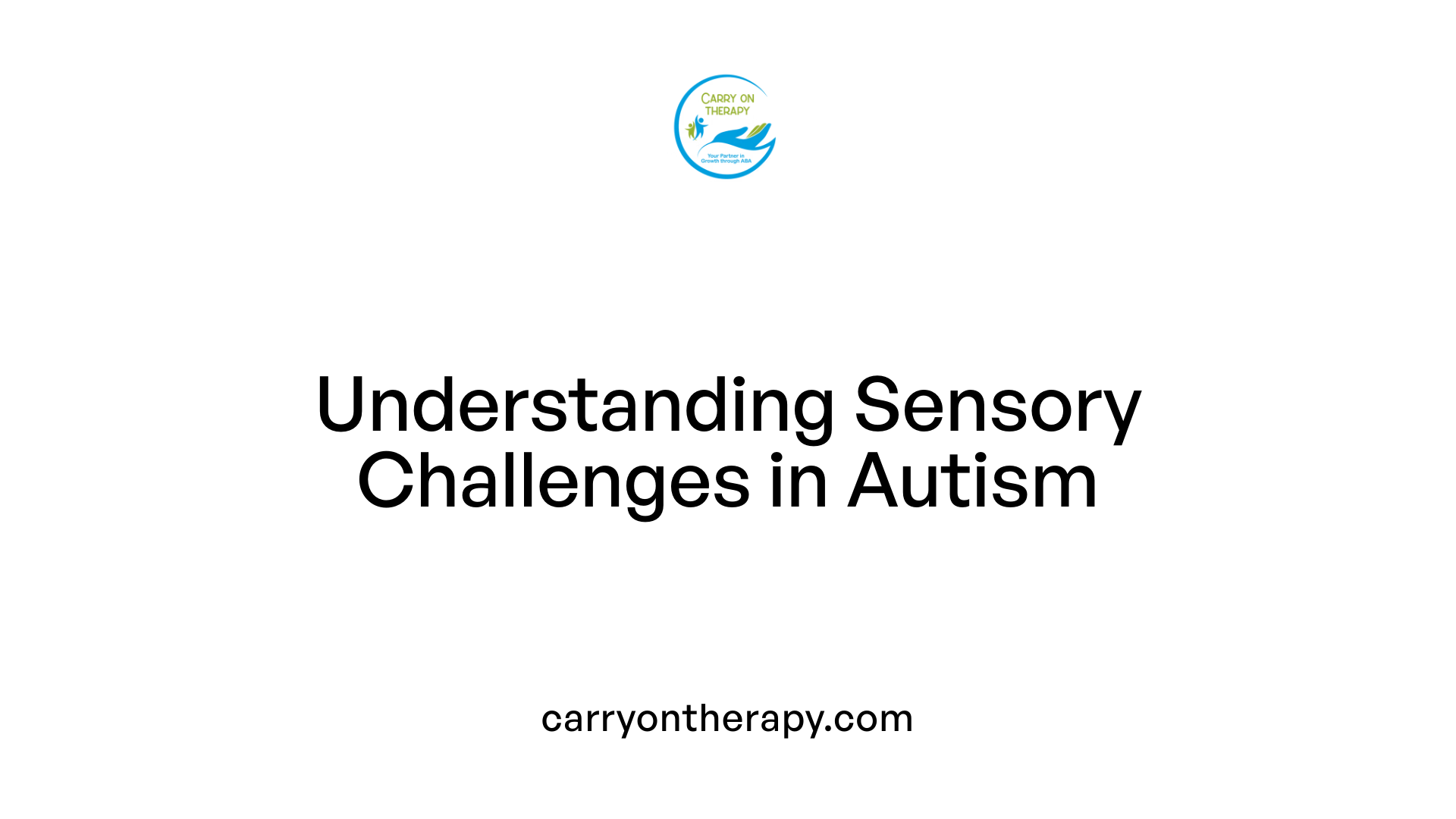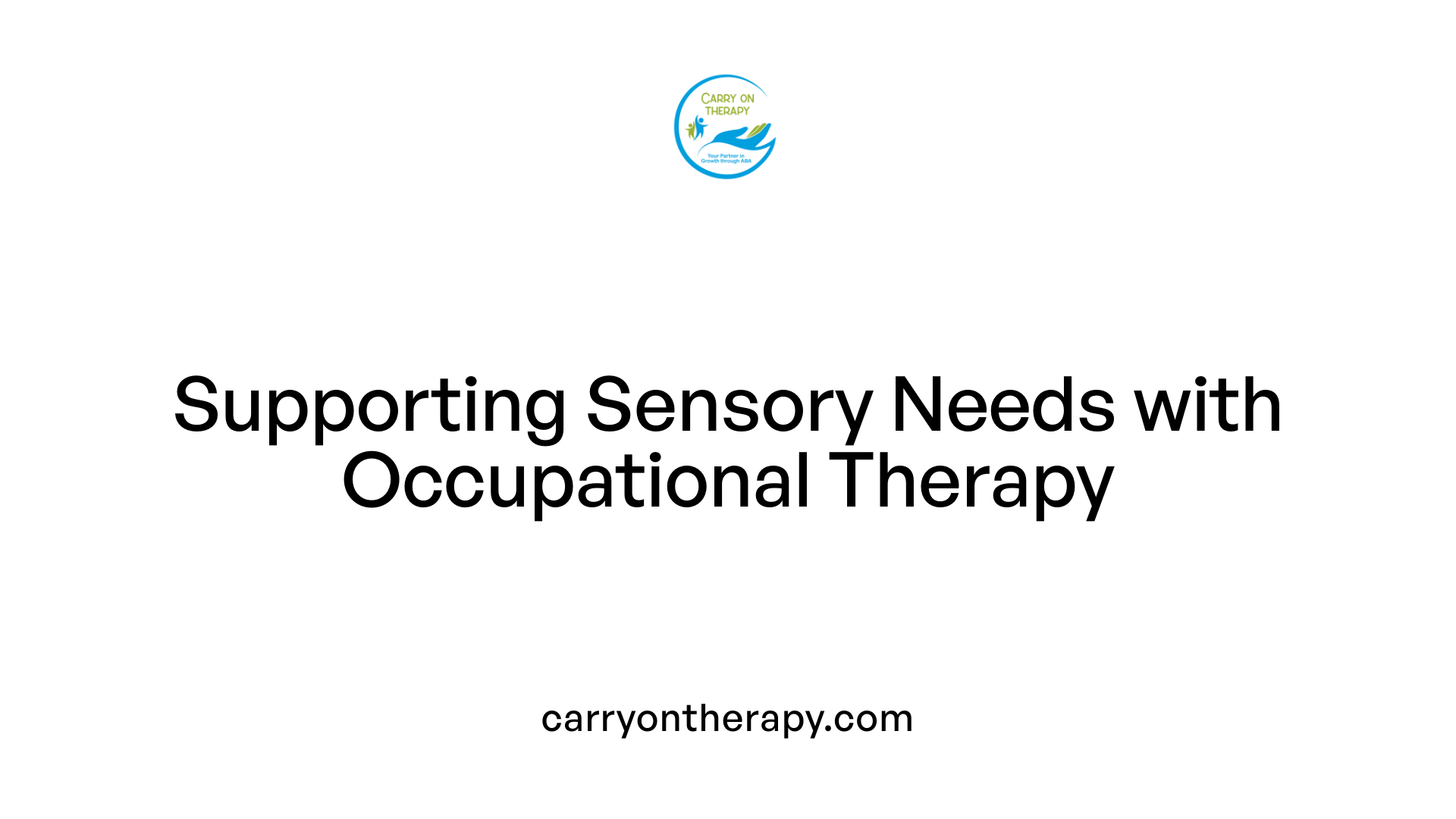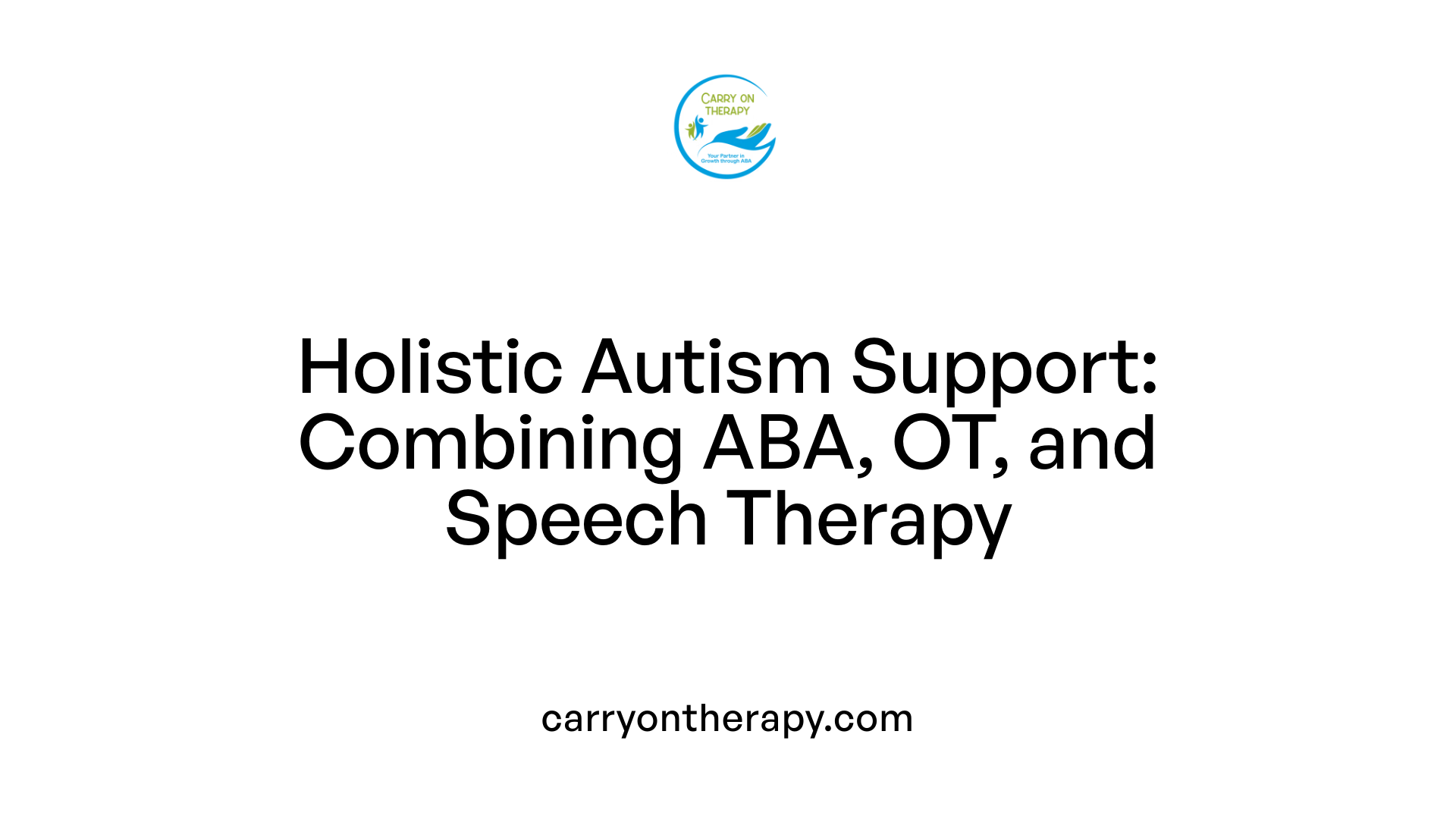Recognizing Sensory Needs in Autism
Understanding the sensory processing challenges experienced by many autistic children is crucial for providing effective support. Sensory sensitivities and difficulties affect nearly all individuals with autism, influencing their behavior, learning, and daily activities. This article explores the sensory needs of autistic children, related therapies, and how behavioral approaches like Applied Behavior Analysis (ABA) integrate with sensory interventions to promote enhanced functioning and quality of life.
Sensory Processing Difficulties in Autistic Children

What sensory processing challenges are common among autistic children?
Sensory processing difficulties are highly prevalent in children with autism, affecting approximately 90–95% of this population. These difficulties often manifest as either extreme sensitivity or insensitivity to sensory inputs such as sounds, textures, lights, or movement.
Types of sensory sensitivities and processing difficulties
Autistic children may struggle with sensory modulation, meaning their response to sensory stimuli can be unpredictable or exaggerated. Some may be overwhelmed by ordinary sounds or touch, while others may not notice sensations that typically draw attention. This sensory modulation difficulty can complicate their ability to regulate central nervous system arousal, leading to increased anxiety or stress.
Impact of sensory modulation on behavior and daily life
Sensory processing challenges deeply affect social communication and may increase restrictive, repetitive behaviors. They also limit participation in leisure activities and make everyday tasks such as eating, sleeping, dressing, toileting, and maintaining personal hygiene more difficult. These barriers can reduce overall quality of life and independence for autistic children.
Understanding these sensory processing issues is essential for tailoring supportive therapies, such as occupational therapy, which either address the underlying sensory integration problems or adapt environments to accommodate sensory needs.
Role of Occupational Therapy and Sensory Integration Therapy

How does occupational therapy support sensory needs in autistic children?
Occupational therapy (OT) plays a vital role in helping autistic children manage sensory processing difficulties, which affect about 90–95% of this population. These challenges can limit their ability to participate in daily activities like eating, dressing, and sleeping. OT employs two main approaches to support sensory needs:
Bottom-up approach: This focuses on improving the underlying sensory processing abilities. Sensory integration therapy (SIT) is a common bottom-up intervention. It is a play-based, clinic-focused method that uses sensory-motor activities emphasizing active engagement and child-directed sensory-rich experiences.
Top-down approach: This involves adapting the environment or modifying daily activities to accommodate the child's sensory sensitivities and preferences, making participation easier and less stressful.
What are sensory integration therapy methods and goals?
Sensory integration therapy aims to improve how children respond to sensory stimuli that may otherwise be overwhelming or restrictive. Through structured, sensory-motor play, SIT encourages development of more typical sensory processing patterns, thereby fostering better engagement in everyday tasks and social situations.
What evidence and limitations exist for sensory integration interventions?
While sensory-based therapies like SIT are promising, current research is limited. Studies often suffer from small sample sizes, inconsistent intervention protocols, and methodological challenges. The notable SenITA trial evaluated standardized Ayres Sensory Integration therapy but highlighted the need for further robust, long-term studies. Systematic reviews stress the importance of additional high-quality research to verify both the clinical effectiveness and cost-effectiveness of sensory integration therapy for autistic children.
Applied Behavior Analysis (ABA) Therapy: Foundations and Benefits
What is Applied Behavior Analysis (ABA) therapy and how does it help individuals with autism?
ABA therapy is a scientifically grounded approach that helps children with autism by focusing on learning and behavior. Its main goal is to increase positive and helpful behaviors while reducing behaviors that may be harmful or interfere with daily life.
How are ABA programs tailored to individual needs?
ABA programs are carefully customized to meet each child's unique skills, needs, interests, and family environment. A qualified Board Certified Behavior Analyst (BCBA) creates and oversees the program, which targets areas such as communication, social skills, self-care, play, motor skills, and academics. Parents and caregivers also play an active role by learning strategies to reinforce positive behaviors and support learning during everyday activities.
What evidence supports the effectiveness of ABA?
Extensive research dating back to the 1960s supports the use of ABA therapy. Over 20 studies highlight that intensive, long-term ABA intervention can improve intellectual functioning, language development, daily living skills, and social abilities. Recognized as an evidence-based best practice by the US Surgeon General and the American Psychological Association, ABA therapy is covered by many insurance plans due to its demonstrated benefits.
| Aspect | Description | Significance |
|---|---|---|
| Science-based approach | Grounded in studies of learning and behavior | Ensures interventions are effective and measurable |
| Individualized programs | Tailored to the child’s unique needs and goals | Maximizes progress and relevance |
| Positive reinforcement | Encourages repetition of desired behaviors through rewards | Builds lasting skills and motivation |
| Professional oversight | Programs designed and monitored by certified BCBAs | Maintains quality and adapts to changing needs |
| Strong evidence base | Supported by decades of research and endorsed by major health organizations | Confirms its status as a best practice intervention |
Key Techniques and Strategies Used in ABA Therapy
What are the common techniques and strategies used in ABA therapy?
ABA therapy utilizes a variety of well-researched methods aimed at encouraging helpful behaviors and diminishing harmful or limiting ones. Central to its success is positive reinforcement, where desired behaviors are rewarded, increasing the likelihood they will be repeated.
Another important technique is Discrete Trial Training (DTT). This approach breaks down skills into small, manageable steps, teaching each step through clear instructions followed by immediate rewards. This systematic method helps learners acquire distinct abilities efficiently.
In contrast, Natural Environment Teaching (NET) focuses on teaching skills within everyday, natural contexts. This technique helps children generalize and apply skills spontaneously during routine activities, enhancing real-world learning.
Task analysis is often used to dissect complex tasks into simpler steps, making learning less overwhelming. Alongside this, prompting provides necessary support or cues to assist the learner when they struggle, and fading gradually removes these prompts to encourage independence.
A crucial part of ABA therapy is parent and caregiver involvement. Families receive training to apply positive reinforcement and learning strategies consistently throughout the day, extending therapy beyond clinical settings. This collaboration ensures skills transfer and maintenance across environments, leading to better long-term outcomes.
Measuring the Effectiveness of ABA Therapy
How is the effectiveness of ABA therapy measured?
ABA therapy's effectiveness is primarily measured through ongoing data collection and assessment of the individual's behavior and skill development. Therapists systematically observe and record behavioral changes during sessions to track progress and identify areas needing adjustment.
Standardized tools play a crucial role in assessing outcomes. Examples include the Vineland Adaptive Behavior Scales (Vineland-3), which evaluate social, communication, and daily living skills. The VB-MAPP (Verbal Behavior Milestones Assessment and Placement Program) assesses language and social skills relevant to ABA goals. Additionally, the Early Functional Language (EFL) assessment may be used to monitor communication improvements.
An innovative resource called the Patient Outcome Planning Calculator (POP-C) assists clinicians and families in planning treatment intensity. The POP-C predicts the level of support a child may require by considering factors such as severity of symptoms and individual needs, helping to tailor therapy dosage effectively.
Progress in behavioral targets and acquisition of new skills is routinely tracked using visual aids like charts and graphs, which make data understandable and facilitate collaborative decision-making between therapists and families.
This comprehensive approach ensures that ABA interventions remain responsive and personalized, maximizing positive outcomes for children with autism.
Professionals Delivering ABA Therapy: Training and Certification
Who provides ABA therapy and what qualifications do professionals need?
ABA therapy is provided by specialized professionals primarily including Board Certified Behavior Analysts (BCBAs) and Registered Behavior Technicians (RBTs).
BCBAs are responsible for designing and overseeing individualized ABA treatment plans. To become a BCBA, an individual must typically hold at least a bachelor’s degree in a relevant field, although many pursue a master’s degree specializing in applied behavior analysis or related disciplines. Alongside formal education, extensive supervised clinical experience—usually between 1,500 and 2,000 hours—is required. After meeting these prerequisites, candidates must pass a certification exam administered by the Behavior Analyst Certification Board (BACB).
Certification is crucial because it assures a standardized level of knowledge and competence. Moreover, many states require licensure that aligns with or builds upon BACB certification, ensuring ethical and effective practice in ABA therapy. Registered Behavior Technicians, on the other hand, work directly with clients implementing therapeutic interventions under the supervision of a BCBA. RBTs complete specialized training and a competency assessment but do not design therapy plans.
Successful ABA practitioners possess a range of skills critical to effective therapy delivery. These include active listening to understand client and family needs, keen observation to monitor behaviors accurately, critical thinking to customize intervention strategies, and strong communication skills to collaborate effectively with families, caregivers, and healthcare professionals.
Overall, the robust training, certification, and skill set required equips ABA providers to deliver evidence-based, tailored therapy that supports the developmental needs of children with autism.
| Provider Role | Educational Requirements | Certification and Licensing | Key Skills |
|---|---|---|---|
| Board Certified Behavior Analyst (BCBA) | Bachelor’s or master’s degree in ABA or related field, 1500–2000 hours supervised experience | BACB certification, state licensure in many cases | Critical thinking, communication, clinical supervision, ethical practice |
| Registered Behavior Technician (RBT) | Specialized 40-hour training and competency assessment | RBT credential through BACB | Implementation of therapy, observational skills, teamwork |
Navigating Challenges and Criticisms of ABA Therapy

What are some criticisms or challenges associated with ABA therapy?
Applied Behavior Analysis (ABA) therapy, though widely recognized as an evidence-based treatment for autism, faces several criticisms and challenges. One common concern is the therapy's structured and intensive nature, which some argue may inadvertently suppress neurodiversity. Critics worry that ABA's focus on modifying behaviors could prioritize conformity over respecting an individual's unique ways of thinking and expressing themselves.
Ethical considerations also play a significant role in the dialogue surrounding ABA. Ensuring informed consent and maintaining respect for the child’s dignity are paramount. There is a growing emphasis on avoiding outdated or overly rigid interventions that might cause discomfort or emotional distress. Setting clear boundaries within therapy helps protect both the child’s autonomy and the therapeutic relationship.
Financial and professional pressures add to the complexity; families often face significant costs, and providers juggle responsibilities tied to regulatory and insurance requirements. These factors can sometimes influence the delivery and accessibility of therapy.
To address these issues, modern ABA programs increasingly incorporate child-centered, naturalistic techniques. Approaches that emphasize positive reinforcement within natural settings, such as pivotal response training, aim to promote meaningful learning aligned with the child's interests and needs. This shift helps balance behavioral goals with respect for individuality and well-being, ensuring interventions are supportive rather than restrictive.
Integrating ABA with Sensory and Developmental Therapies for Holistic Support

How can ABA be combined with occupational therapy and speech therapy?
ABA therapy primarily focuses on increasing helpful behaviors and reducing hindering behaviors using techniques like positive reinforcement and the A-B-Cs behavior model. However, many children with autism also face sensory processing difficulties and challenges in communication.
Occupational therapy (OT) complements ABA by addressing sensory integration issues, which affect participation in daily activities such as eating, dressing, and sleeping. OT uses sensory-motor activities and environmental adaptations to support regulation and functional skills. Speech therapy, meanwhile, targets improving understanding and use of language, which is essential for effective communication.
When combined, ABA can create individualized behavior goals that include communication and social skills, while OT and speech therapy enhance sensory processing and language abilities. Together, these therapies provide a powerful, coordinated approach to addressing the diverse needs of children with autism.
What roles do developmental and educational approaches play in autism support?
Beyond ABA and sensory interventions, developmental therapies like speech therapy address language delays and promote independent living skills. Educational programs such as TEACCH adapt learning environments with visual supports and consistent routines, helping children engage successfully in school settings.
Social-relational methods, including DIR "Floor Time" and social stories, focus on enhancing emotional bonds and social understanding, often involving family members to foster meaningful relationships. Psychological interventions like cognitive-behavior therapy manage associated mental health challenges by working on thoughts and behaviors.
This blend of developmental, educational, and psychological approaches ensures that therapy addresses multiple aspects of a child's growth and well-being.
Why is individualized, multidisciplinary care important?
Each child with autism has a unique set of skills, needs, and sensitivities. A qualified behavior analyst (BCBA) customizes ABA programs, while occupational therapists and speech-language pathologists tailor their services to the child's profile. Assessment, goal setting, regular data collection, and evaluation guide adjustments to ensure progress.
Collaboration among these professionals, alongside training for parents and caregivers to support learning in natural settings, maximizes outcomes. Multidisciplinary care addresses sensory challenges, communication, behavior, social skills, and academic development cohesively.
By integrating these therapies, children with autism can experience comprehensive support that promotes enhanced daily functioning, social participation, and quality of life.
Accessing ABA and Sensory-Based Services: Steps and Considerations
Consulting Medical Providers
The first step in accessing ABA and sensory-based services often involves consulting with a medical provider, such as a pediatrician or developmental specialist. They can help assess the child's needs, recommend appropriate therapies, and provide necessary referrals or diagnoses that insurance companies may require.
Insurance Coverage and Mandates
Many private insurance plans and Medicaid programs are required to cover medically necessary ABA services for children with autism. It's important to verify insurance coverage specifics ahead of time, clarifying what services are included, any limits on therapy hours, and associated costs. Understanding these details helps families plan for therapy without unexpected expenses.
Finding Qualified Providers
Qualified ABA providers include Board Certified Behavior Analysts (BCBAs) who design and oversee therapy programs, and Registered Behavior Technicians (RBTs) who implement therapy directly. Sensory-based services, such as occupational therapy with sensory integration techniques, should also be provided by licensed and trained professionals. Families can use online directories, professional associations, and recommendations from medical providers to find suitable practitioners.
Evaluating Fit for Child and Family
Selecting the right provider requires assessing how well the therapy fits the child's unique needs, interests, and family situation. This includes reviewing the provider's approach, communication style, and willingness to involve parents and caregivers in training and support. Early meetings or trial sessions can help determine if a good match exists, which is crucial for successful intervention outcomes.
Supporting Sensory Needs Through Evidence-Based, Individualized Care
Addressing the complex sensory needs of autistic children requires a deep understanding of sensory processing challenges and their impact on behavior and daily functioning. Evidence-based approaches like Applied Behavior Analysis offer scientifically validated methods to promote meaningful skill development and behavior improvement. Meanwhile, occupational therapy and sensory integration therapies provide critical support for sensory modulation difficulties, enhancing participation in everyday activities. Combining these therapeutic models within an individualized, family-centered framework ensures that interventions respect neurodiversity and promote autonomy. As research evolves, continued collaboration among families, therapists, and healthcare providers will remain essential to optimize outcomes and quality of life for autistic children facing sensory challenges.
References
- Applied Behavior Analysis (ABA)
- Sensory integration therapy for children with autism ... - NCBI
- Treatment and Intervention for Autism Spectrum Disorder
- How to Become an ABA Therapist - School of Education
- How to Become an Applied Behavior Analyst (ABA) Therapist
- Applied Behavior Analysis (ABA)
- ABA Therapy Examples, Definition & Techniques
- Autism
- Therapeutic Approaches for Boosting Motor Skills in Children
- A Tool for Determining Treatment Dosage in Applied Behavior ...
You have to Start to be Great!






